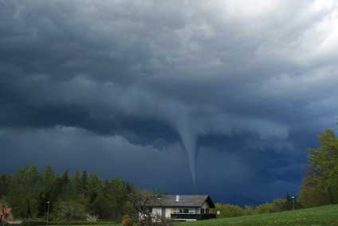Storm warning signs
Windstorms are part of life throughout Canada Hurricanes or post-tropical storms affect the east coast each year, as do typhoons on the Pacific side. While tornadoes are usually associated with Tornado Alley in the United States, as many as 60 tornadoes are confirmed in Canada each year.
Many windstorms come on quickly, without much warning. Most of the time, though, weather forecasts will offer sufficient warning to get prepared. Hurricanes in particular telegraph their movements many days in advance.
Paying attention to weather forecasts throughout the year is your first defense against dangerous storms of all kinds.
However, tornadoes can appear suddenly and move very quickly, often leaving vast areas destroyed in their wake. No matter the size, tornadoes can uproot trees, demolish homes, destroy personal property, sheds, and swimming pools, and overturn cars. The power of a tornado is both terrifying and amazing.
Warning signs of a potential tornado include:
- Severe thunderstorms, with frequent thunder and lightning
- A dark sky, often with green or yellow clouds
- A rumbling sound, or a roar, that lasts longer than ordinary thunder
- A funnel cloud, often accompanied by heavy rain or hail
- A debris cloud, even if there is no actual funnel visible.
- Heavy hail, often with no rain
Preparing your home for windstorms
There is plenty you can do to keep your home and your family ready for windstorms. It’s best to be as prepared as possible, so you don’t need to panic if meteorologists issue a storm warning.
Also keep in mind that many windstorms carry heavy rain as well. We’ve also got a guide to preparing your home for heavy rain.
Keep your home roof well maintained
When heavy winds strike a house, it’s often the roof that bears the worst of the damage. Depending on the type of roof on your home, it’s useful life is probably only 20-30 years. Roofs older than that face serious risk in heavy winds.
You should have a qualified professional inspect your roof regularly, especially once it’s nearing the end of its expected life.
If you notice any missing or loose shingles, have them repaired immediately—you don’t want to be scrambling to do so as a windstorm bears down on your house.
Take care of trees and landscaping
If you have any trees on your property, take note of any dead or dying branches. These should be removed promptly, as they can easily become dangerous projectiles in a windstorm (not to mention potentially falling on someone).
If any trees near your home die entirely, you’ll need to remove them. If you’re not comfortable doing it yourself, consult with a qualified arborist.
Have a safety plan and an emergency kit
Windstorms of all types can be chaotic and dangerous; you don’t want to be panicking and wondering what you need to do while hurricane-force winds are swirling around your house. Create a home safety plan that you can follow during all sorts of potential disasters.
Your safety plan should cover things like potential evacuation routes, how and where the family should meet up if they’re separated, how to contact one another during an emergency, and so on. You should also plan for living without power for several days, as windstorms usually cause widespread power outages.
Your home should also have an emergency kit with basic supplies like a first aid kid, flashlights, batteries, a radio, and other useful equipment.


